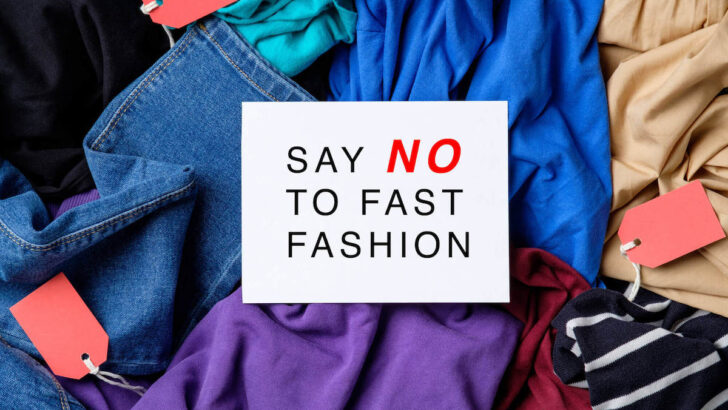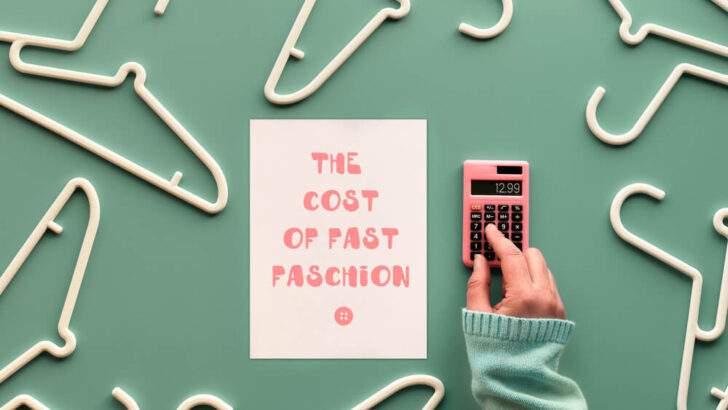Fast fashion has taken the fashion industry by storm, offering trendy and affordable clothes that are updated every few weeks. While it may seem like a great deal for fashionistas on a budget, the truth is that fast fashion has serious consequences for our environment, our closets, and society as a whole.

In this post, we’ll explore what exactly fast fashion is, how it affects us, and what we can do to shop like we give a damn!
Fast fashion is a term used to describe clothing that is designed and produced rapidly and inexpensively to meet the latest trends.
Big brands such as H&M, Zara, and Forever21 are some of the most popular examples of fast fashion. Think of the places you used to shop at in the mall…it’s probably mass produced clothing.

These brands regularly release new collections, with clothing sold at low prices. To put it simply, the purpose is to produce cheap clothing to keep up with rapidly changing fashion trends, provide consumers with affordable clothing options, and keep customers coming back to buy more.
But what are the consequences of fast fashion?
The fashion industry thrives on consumers viewing clothing as disposable and always wanting to shop for the next best thing. Plus, if the clothing is made with cheap materials and doesn’t last…the customer has to purchase new clothes.
“The average American now generates 82 pounds of textile waste each year. That adds up to more than 11 million tons of textile waste from the U.S. alone.”

Environmental Impacts
From that statistic we can see that one of the most significant issues with fast fashion is its environmental impact. The amount of waste produced and the continued mass production of these garments requires a large amount of resources such as water, energy, and chemicals.
Ethical Issues
The cost of producing garments at such low prices is often done through outsourcing and underpaid labor in developing countries. The companies benefit from the exploitation and mistreatment of workers and are often linked to human rights violations such as child labor, unsafe working conditions, and inhumane working hours.
Sadly, this can lead to tragedies like Rana Plaza. When this garment factory collapsed over 1100 garment workers were killed. And popular brands failed to take responsibility.

The sheer volume of fast fashion produced results in a tremendous amount of waste that cannot typically be recycled, contributing to the global pollution problem.
Moreover, fast fashion also hurts our society. The cost of producing garments at such low prices is often done through outsourcing and underpaid labor in developing countries. The companies benefit by the exploitation and mistreatment of workers and are often linked to human rights violations such as child labor, unsafe working conditions, and inhumane working hours.
The local fashion industry of countries is disrupted due to the influx of cheaper clothing, causing local businesses and workers to be outcompeted. Buying fast fashion supports these practices.
Give a Damn with Your Shopping Habits to Inspire Change
So, what can we do to make a difference? One solution is to support sustainable fashion practices.
Choose More Sustainable Brands
Slow Fashion is an excellent alternative for fast fashion, as it emphasizes the use of sustainable and high-quality materials, the use of ethical production methods and emphasizes upcycling and recycling. Supporting brands with these positive values supports more eco-conscious and ethical practices.
Shop Secondhand
Another solution is to choose to shop at thrift stores or consignment shops. This reduces waste and supports circular economy practices which can save money in the long run rather than buying cheaper products more frequently.
You can probably find thrift stores locally or check out this list of online thrift shops if you prefer purchasing online.
Value What You Have
Loving the clothing that is already in your closet is one of the most sustainable things we can do! Wear the clothes in your closet instead of buying new ones. You can always find ways to upcycle old pieces or fresh ways to style clothes that have been sitting in your closet.
Buy Less
Finally, becoming a mindful shopper by buying fewer, higher quality and timeless garments can contribute to breaking the cycle of constant consumerism that is the foundation of fast fashion.

If you decide to purchase new clothing try to invest in pieces that will last for years to come.
This sustainable practice can also help save money in the long run!
Fast fashion may seem like a great deal in the moment, but the reality is far from it. The environmental, ethical, and social consequences of fast fashion are far-reaching, affecting the world around us. However, there are steps we can take to make a difference.
By choosing to support more conscious brands, we can work towards a more sustainable and ethical future. It’s crucial that we engage in conversations and implement small changes in our everyday lives to support this shift towards sustainable fashion practices.
Let’s shop like we give a damn in order to move towards a fashion industry that values sustainability and ethicality over styles that disappear as quickly as they come.